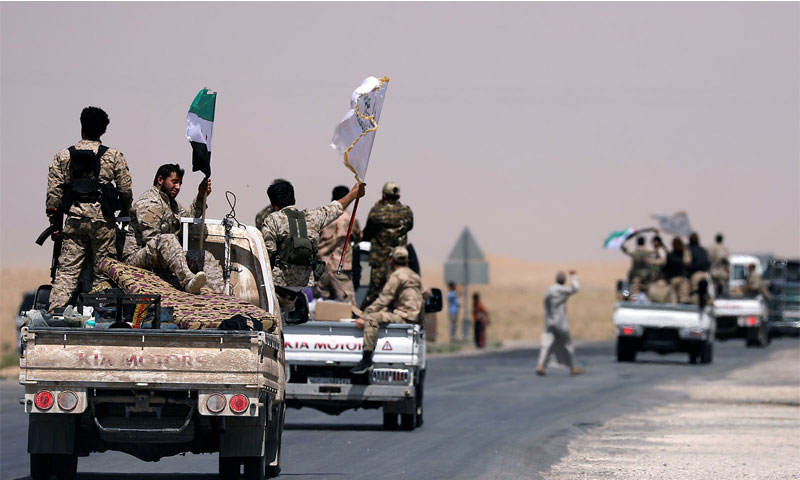Enab Baladi – special
In the vicinity of the city of Raqqa, the main stronghold of ISIS in Syria, field operations are accelerating. It has not been a week since the announcement of the “great” battle to control the city until “Syrian Democratic Forces,” also known as QSD, broke into the city’s eastern and western neighborhoods.
The Kurdish forces have achieved a significant incursion compared to the previous military operations they have launched to control the city. They have relied mainly on aerial cover that is provided by the aircrafts of the International Alliance, in addition to the element of large numbers, which tries to disperse the military force of ISIS. The Alliance attempts also to move to the street war which ISIS has been preparing for since the last three months.
6 Axes and 18 Military Bodies
On June 6, Syrian Democratic Forces announced its fifth and “grand” phase to control the city. “After our heroic resistance in Deir Ez-Zor, Manbij and Kobani and the liberation of all the villages surrounding Raqqa, we announce the beginning of the great battle to liberate the alleged capital of terrorist and terrorism,” declared QSD.
They explained that so many other forces participated in the battle, including “People’s Protection Units,” “Women’s Protection Units,” “The Army of Revolutionaries,” “Jabhat Al-Akrad,” “The Northern Democratic Brigade,” “Tribal Forces,” “Homs Commando Brigade,” “Raqqa Hawks Brigade,” “Al-Tawhid Brigade,” “Seljuk Brigade,” “Al-Sanadid Forces,” “Syriac Military Council,” “Manbij Military Council,” “Deir Ez-Zor Military Council,” “The Elite Forces,” “Self Defense Forces,” ”Raqqa Civil Council,” “Syrian Democratic Council” and “Dignitaries and Chiefs of tribes.”
The Mishlab neighborhood, which is situated on the eastern side of Raqqa, was the departing point of the military operation in the city. On 9 June, the forces announced full control over it following the extensive progress they had made in the villages of Al-Nozha, Tell Zeidan and Al-Samra.
According to the map of field control, Syrian Democratic Forces’ battle started from six axes: three of which on the eastern side, two on the northern side and one on the western side.
Their military operations are mainly concentrated in the east and they are trying to crawl deeper into the main stronghold of ISIS.
On the other side, the western part of the city is also making some progress.
On June 10, Syrian Democratic Forces took control of Al-Sabahiya neighborhood, the western gate of the city.
Thus, they became present in the outskirts of three neighborhoods: Hattin, Al-Qadisiyyah and Romaniya. They announced also their incursion into Romaniya and their approaching control over it.
In the context of military operations, the US envoy of the International Alliance, Brett H. McGurk, declared that the pace of the campaign, which is backed up by the US, to control Raqqa in Syria “is accelerating.”
He also explained that “Raqqa campaign is moving forward and is similar to what happened in Mosul.”
Phosphorus Targeting the City
On the other hand, the pro-regime News Agency “Amaq” displayed several videos indicating that the city neighborhoods were bombed by burning Napalm and White Phosphorus, amid artillery shelling by Kurdish forces on residential areas.
It considered that, since the first day of military operations, the aircraft of the International Alliance “burned” Raqqa city with white phosphorus and caused tens of injuries and casualties among civilians.
Identical sources confirmed targeting the city with phosphorus, what infuriated the U S press against the forces of the Alliance that took part in the attack.
The UNICEF declared that 25 children were killed and others were injured as a result of the first three days of the intensive battles in Raqqa, in addition to the survival of more than 40,000 others who are trapped in the line of clashes.
The UNICEF spokesman, Christopher Pollock, stated in a news conference that “the extreme violence in Raqqa threatens the lives of more than 40,000 children who are trapped in extremely dangerous conditions.”
He announced that 80,000 children were displaced from their areas as a result of the clashes and called for the safe evacuation of children from the Governorate.
Al-Assad Forces Are Trying to Break into the Governorate
In addition to the progress of Syrian Democratic Forces, Al-Assad and allied militias broke into the administrative border of the Raqqa Governorate.
They took control over the villages of Dibsi Afnan, Mushrifat Al-Haj, Khirbat Mohsen, Khirbat Al-Sabaa, Khirbat Hassan, Al-Salihiyah and Al-Tarqawi.
This progress comes as a result of the support of Russian aircrafts in addition to the elite forces of Al-Assad and his most notable supporting militias, especially “Tiger Forces” and “Lebanese Hezbollah.”
In conjunction with Al-Assad’s progress Ilham Ahmed, the joint president of the “Democratic Syria” Council, stated that Al-Assad forces “bombed our forces in rural Raqqa in order to obstruct the campaign of the liberation of the city.”
A military source in the Syrian regime had previously told Reuters, in 2016, that Al-Assad forces intend to move to the Governorate of Raqqa, the main stronghold of ISIS in Syria.

